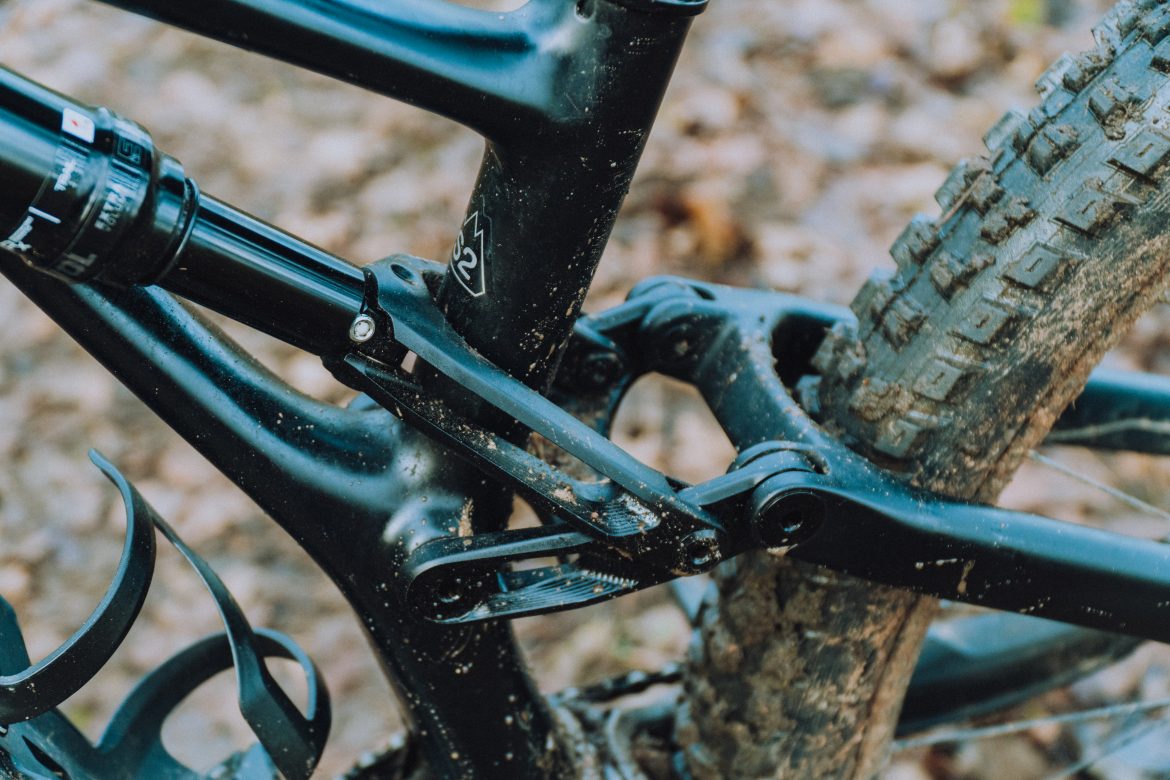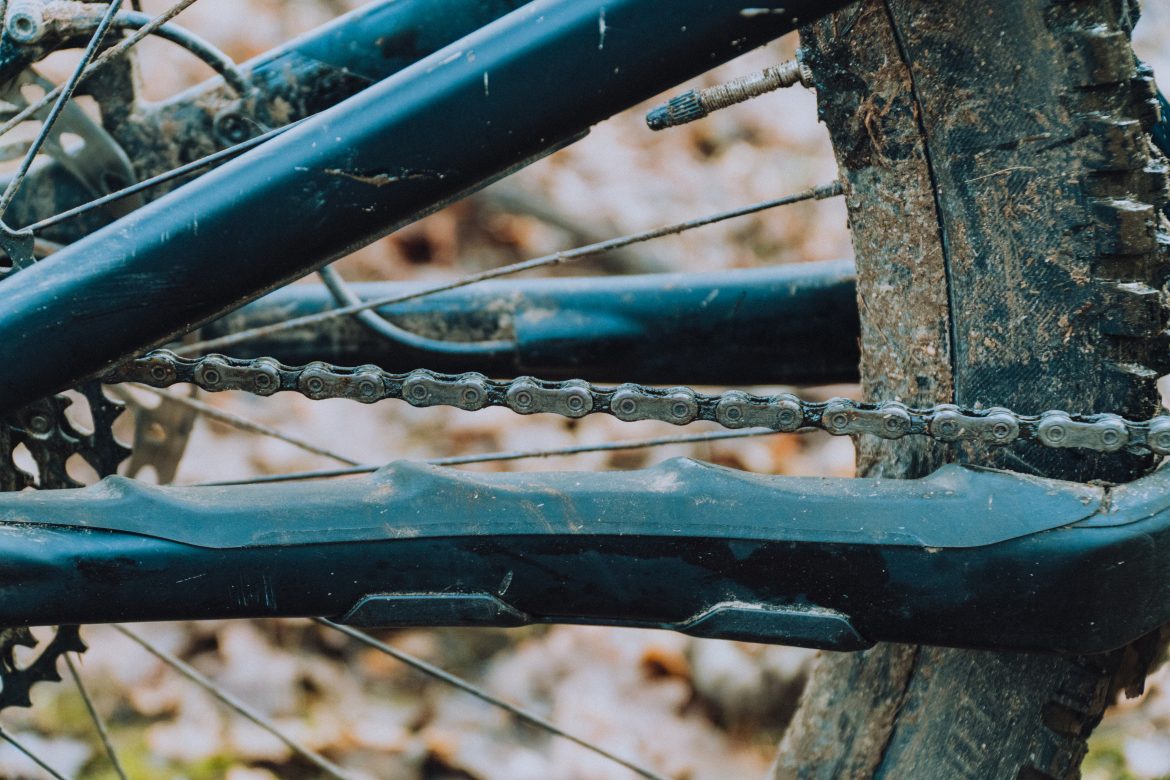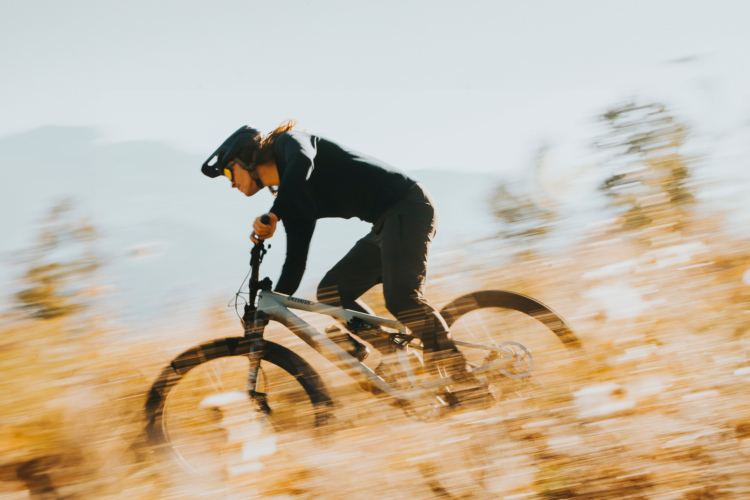
Editor’s note: Our review of the current generation Specialized Stumjumper is here.
A few months ago, Singletracks received a 2021 Stumpjumper Evo Comp for a long-term review. Since this In for Test, we have been putting this “do-it-all” bike through its paces.
The latest iteration of the Stumpy Evo boasts 150mm of rear travel paired with a 160mm fork, and it now only comes in a 29″ wheel option. However, for those so inclined, there is the possibility to turn the bike into a mixed-wheel steed with an aftermarket “mullet link.” The Specialized Stumpjumper Evo is marketed as a do-it-all, “downhill oriented” trail bike, but then, aren’t most bikes these days? That said, the Evo has been a popular model since its introduction a few years ago.
There are a few things that could potentially set this bike apart from the competition. First, the adjustable geometry offers more than just slight tweaks; the head angle can be slackened from 65.5 to 63 degrees for a fairly dramatic change in just 15 minutes. Aside from the ability to really mix up the geometry on this bike, it feels like it has been set up to make the ride easier, with the SWAT box in the downtube and, for some models, a SWAT tool built into the stem.



I have been riding the bike mostly on my local trails in the UK, but these have included a mix of rocky, steep, and natural trails as well as some longer pedal days and more manicured, flowy trail-center rides. The conditions this winter also allowed me to test it in snow, mud, and rain. This test bike has really had to deal with the worst of the UK winters.
The Stumpjumper Evo frame

When purchasing the Stumpjumper Evo, no matter which build you select you’ll get the same FACT 11m carbon front and rear triangle which is a little lighter than previous Evo iterations. Specialized also introduced different carbon layering for each frame size, making the smaller bike less stiff than the larger ones, for a consistent ride feel across the size run.
The frame is offered in a range of colors, depending on the build choice. The Stumpjumper Evo Comp comes in Gloss Clay/Black and Satin Black/Smoke, with the bike on test being the latter. My favorite color by far is the Expert version with a Gloss Carbon and Oasis finish.
The EVO is available in S1-S6 sizes with S5 and S6 getting longer chainstays of 438mm or 443mm, respectively, to accommodate taller riders.
Like with many other bikes in their line-up, Specialized really did think about the small details with this Specialized Stumpjumper Evo: internal cable guides, chain slap and downtube protection, and a threaded bottom bracket across the range. However, some features make this bike stand out from the others. Namely the SWAT box, which is 15% larger than before, and the SWAT 650ml bladder so you can also use it to store extra water. The SWAT water bottle cage fits a water bottle but also carries a small multitool which is a nice touch. If your aim is to ride without a pack, this is probably up there as the best bike in that regard.



Considering the current weather in the UK, the frame has held up well. No bearings wore out, and the frame does not appear to have a rear “mud shelf” that you have to scoop out after every ride.
Stumpjumper Evo Geometry
| S1 | S2 | S3 | S4 | S5 | S6 | |
|---|---|---|---|---|---|---|
| Crank Length | 165mm | 170mm | 170mm | 170mm | 170mm | 175mm |
| Stem Length | 40mm | 40mm | 50mm | 50mm | 50mm | 50mm |
| Seatpost Length | 100 mm | 125 mm | 150 mm | 170mm | 170 mm | 190 mm |
| Saddle Width | 155mm | 155mm | 143mm | 143mm | 143mm | 143mm |
| Handlebar Width | 800mm | 800mm | 800mm | 800mm | 800mm | 800mm |
| Reach | 408mm | 428mm | 448mm | 475mm | 498mm | 528mm |
| Stack | 613mm | 617mm | 626mm | 635mm | 644mm | 654mm |
| Wheelbase | 1167mm | 1191mm | 1216mm | 1247mm | 1285mm | 1319mm |
| Chainstay Length | 438mm | 438mm | 438mm | 438mm | 448mm | 448mm |
| Front Center | 732mm | 756mm | 780mm | 809mm | 838mm | 873mm |
| BB Drop | 40mm | 35mm | 35mm | 35mm | 35mm | 35mm |
| BB Height | 335mm | 340mm | 340mm | 340mm | 340mm | 340mm |
| Seat Tube Angle | 78° | 77.6° | 77.2° | 76.9° | 77° | 77° |
| Seat Tube Length | 385mm | 385mm | 405mm | 425mm | 445mm | 465mm |
| Bike Standover Height | 733mm | 764mm | 763mm | 762mm | 767mm | 770mm |
| Fork Rake/Offset | 44mm | 44mm | 44mm | 44mm | 44mm | 44mm |
| Trail | 131mm | 131mm | 131mm | 131mm | 131mm | 131mm |
| Fork Length (full) | 561mm | 571mm | 571mm | 571mm | 571mm | 571mm |
This bike is one of the most adjustable in its category. With a switch of the headset cup and the chainstay chip, you can give it a head angle almost as slack as a Specialized Demo. At the same time, if you’re planning a long day on the bike, with the same setup, you would be able to shift the bike to a more pedal-friendly 65.5° head angle. The changes can be done relatively quickly with a few tools, though so far I haven’t tried adjusting on the trails. As would be the case for most riders, I have spent most of my time with the bike in a fairly middle-of-the-road setting, though its safe to say the 63° head angle feels noticeably different.
There are other ways to adjust the geometry of the bike. Due to the relatively low standover height across the range, differing by 6mm from size S2 to S6, there is a potential to really narrow down the right reach without compromising the standover. Being 5’6″ and preferring more maneuverable bikes I chose to try an S2. It’s the equivalent to a small for most other brands I think, with a fairly progressive 428mm reach.
I found the size S2 was a good fit for my requirements. I didn’t struggle to get going on the bike, nor did I feel hunched or scrunched on the Stumpjumper Evo.
Specialized Stumpjumper Evo Suspension




Unlike the updated Stumpjumper, the Evo version still utilizes a Horst-link design. It might look like not a lot has changed regarding suspension, but Specialized would say that is not the case.
The leverage curve has now been aligned closely with the recently updated and somewhat burlier Enduro. The axle path has also changed at the start of the stroke, moving more rearward, which should help the bike maintain speed on square-edged hits. The change in progressivity also opens up the possibility to use a coil, which you can find on the mixed-wheel build, and which has been an option on previous iterations of the Stumpy Evo. Most of the bikes in the range are specced with a Fox Float DPX2, with the shock being tuned differently for each frame size.
The Horst-link platform feels fairly efficient when pedaling, though not overly so, and I have definitely ridden trail or enduro bikes that feel firmer. When met with technical climbs though, the bike feels adept at keeping the wheel stuck to the ground. It is worth noting that I did not need to lock the suspension out on most climbs other than the longest and most arduous fire roads.
When descending, the bike was always very poised through any rocky descends. It doesn’t feel like the endless, bottomless suspension of an old Specialized Status but it maintains traction and composure well on challenging chattery trails.
Specialized Stumpjumper Evo Components



The Stumpjumper Evo Comp is the most affordable bike in the range and comes with a Fox 36 Rythm and a DPX2 Performance shock, and a build kit handled mostly by Shimano. The bike’s spec feels fairly appropriate for its intended purpose, though there are obvious weight savings to be made when moving up through the range that come at a financial cost. The Specialized Evo Comp S2 weighs 33 pounds without the pedals and retails for $4,000 (€4,499).
I was impressed with how the Shimano SLX groupset performed. With a 10-51T, 12-speed cassette, the uphills were not that hard, and in comparison to other groupsets, it shifts fairly seamlessly and consistently, even when mashing through gear shifts on climbs.
The SLX 4-piston brakes indicate this bike’s intended use and offer up enough stopping power with the 180mm and 200mm rotors. However, I still find it a little bit disconcerting when a Shimano brake needs a little pumping to get it working, which was the case with these SLX brakes.


The tire combination also inferred that the bike is intended for rowdier things than the non-Evo version. I was surprised at how wide both the Eliminator and Butcher actually are despite the 2.3″ advertised width.
If you are looking at one of the smaller frames, I would recommend swapping the dropper out for a longer one. I found the 125mm drop isn’t enough, especially considering the low seat tube height. Also, I would consider upgrading the suspension at a later date. Though satisfactory, it was fairly limited in terms of adjustment.
The Ride

This bike is a good climber, but then you would really expect that given the Stumpjumper’s heritage. Fire road climbs might not be the Evo’s specialty, but the bike shines when faced with a technical climb. Being on a shorter frame in terms of the overall wheelbase, I benefited both from 29″ wheels being able to roll over things and still being agile enough to throw around corners. The suspension tune and the tire traction kept me in check on rocky or rooty ledges. Moreover, it didn’t feel too energy-sapping on those rare out of saddle climbs.
With the high bottom bracket setting, I did not hit my pedals often; however, I did suffer a few pedal strikes when in the low setting. Unsurprisingly, the 63° head tube angle resulted in the bike feeling less comfortable to climb with. It felt slower, and I did struggle to turn the same switchbacks which I cleaned in a mid-range head tube angle setting.
Despite its roots, the Stumpjumper EVO is obviously a bike more focused on the descents, and you can immediately tell when you set off from the top of the trail. It is just one of those bikes that leaves you feeling at home straight away. There was nothing I really had to get used to and the fit felt just right like I was sitting in the bike rather than over it. The modern, but not excessively long, reach reminds me of a 27.5″ bike rather than a 29er. I’m able to maneuver it around tight steep corners and quickly change direction. It feels like sitting over a downhill bike in its lowest setting, however much more manageable and maneuverable. When riding rocky and fast sections, you can still feel feedback from the ground, and it did feel possible to overwhelm the DPX shock on repeated hard hits, but I struggled to find something that the bike couldn’t cope with.
The bike does feel lighter than it actually is. Even with my questionable jumping ability, I was able to lift the Stumpy off the ground with no problem, and the climbs were often easier than on some of the 30-pound bikes I have ridden before.
Summary

This bike is designed for the rider that enjoys long days in the saddle but is undeniably more focused on enjoying descents. If you are looking for an out and out trail bike then the Evo is probably not that. I suspect the standard (and somewhat lighter) Stumpjumper might be worth considering in that case. On the flip side, I found myself struggling to justify a bigger, more traditional enduro machine (like Specialized’s eponymous Enduro) when the Evo feels so capable on rough and challenging terrain.
However, the real selling point here is that, with its adjustable geometry, you can go for a day-long trail ride and the next day take it to the bike park and still have a good time at both. The potential to change the bike into a mullet setup using an aftermarket link also adds to its adaptability. The term “quiver killer” is overused these days but for riders who enjoy trail riding, enduro racing, and some bike park days then this is a serious contender for that title.
The wide range of specifications and pricing will also mean that most riders can find a model that suits their budget and preferences. The Comp model we had on test is probably the best value for the money across the range. With a price tag of $4,000, you get everything this bike needs to get out on the trail and it allows for later upgrades to fancier, more adjustable components since the frame is exactly the same on the pricier and lighter versions. The only thing that lets down this spec is the weight of the components and the short-travel dropper post.
This bike also likes to make thing easy for the rider, with multiple, well-thought-out details like the range of SWAT accessories, the solid finishing kit from Shimano (perhaps less to the SLX brakes), and also the independent bottom bracket and head tube angle geometry adjustments that actually change how the bike rides dramatically.
I am struggling to think of a bike I have enjoyed riding more in recent years. The Stumpjumper Evo is a smart, well thought out bike that can handle pretty much anything you can chuck at it, including longer rides. It has definitely left me reconsidering my current bike, and I am looking forward to giving the Evo a go again sometime soon.
- Price: $5,400
- Available at Specialized.

























2 Comments
Feb 12, 2021
Sep 7, 2021